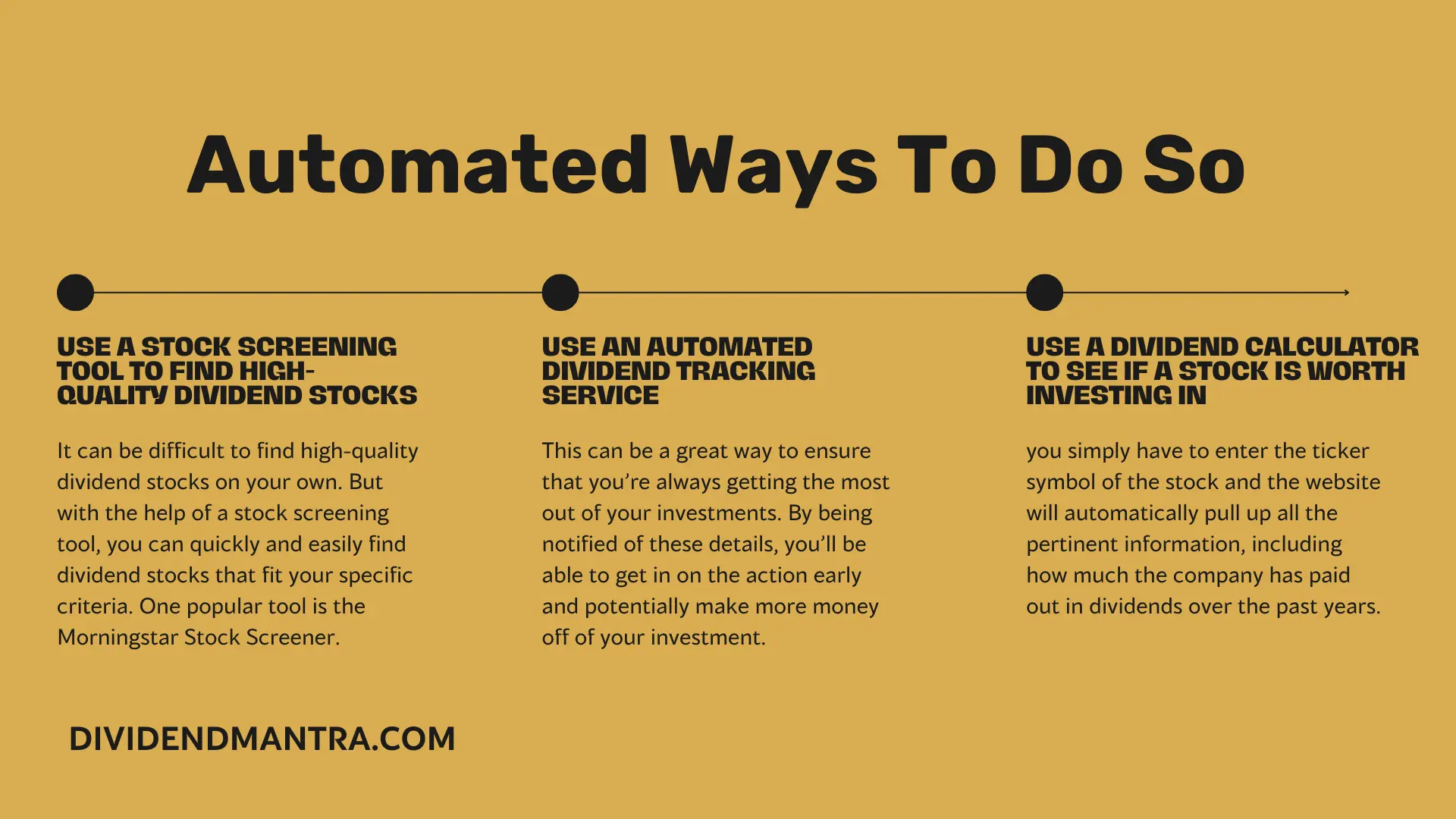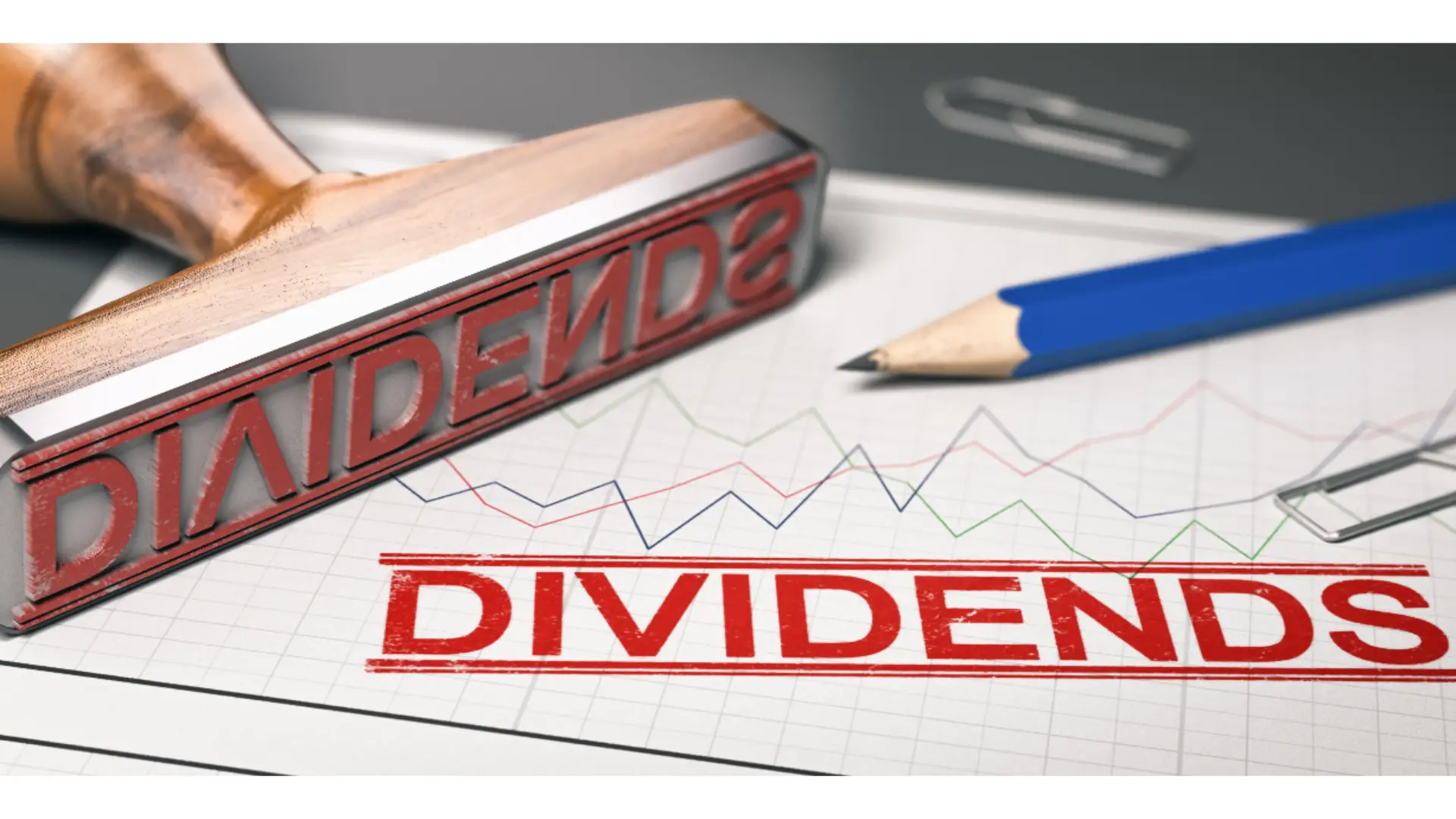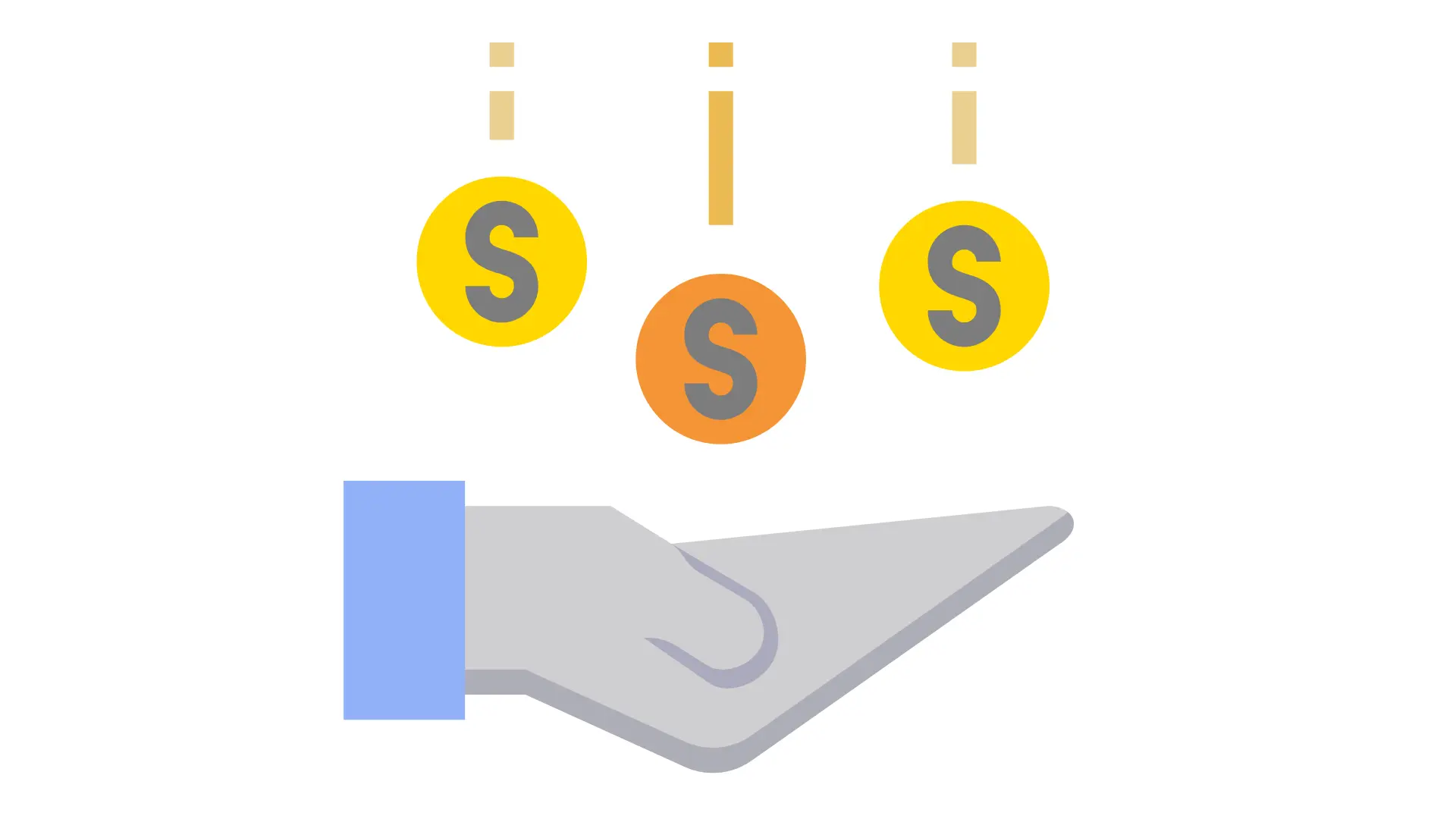How To Find Dividend Stocks
Dividend stocks offer investors a way to achieve a higher return while also providing stability and safety. To make the best decision when selecting dividend stocks, it is important to understand how to find them and what factors to consider. Keep reading to find out how to do so.
What Are Dividend Stocks and Why Should You Invest in Them?
A dividend is a payment made by a company to its shareholders out of its profits. The payment of dividends is usually decided by the board of directors and is usually paid on a regular basis, such as quarterly or annually.
Dividend stocks are stocks that pay regular dividends to their shareholders. These dividends can be in the form of cash payments, but they can also be in the form of additional shares of stock.
People invest in dividend stocks for a number of reasons. The main reason, however, is income.
Dividend-paying stocks provide a steady stream of income, which can be very helpful during retirement. Another reason to invest in dividend stocks is the potential for capital gains. Many dividend-paying stocks offer healthy yields, which can help your portfolio outperform the overall market. Also have a look at the pros and cons of dividend stocks.
Ways To Find Dividend Stocks
A. Manual Ways To Do So
1. Scan the Standard & Poor’s 500 Index for Companies That Pay Dividends Every Quarter, Bi Annually, or Annually
Looking for dividend stocks? There is no need to look any further! The Standard & Poor s 500 Index is a great place to start. This index includes 500 of the largest U.S. companies, and many of them pay dividends on a regular basis.
You can scan the list for companies that pay dividends every quarter, every six months, or every year. This is a manual way to find dividend stocks, but it can be helpful if you want to target a specific type of company.
For example, if you’re looking for high-yield dividend stocks, you can focus on companies that pay quarterly dividends. Or if you’re looking for more stable dividend stocks, you can focus on companies that pay annual dividends.
2. Check Out Financial Content Websites (Like Ours) for Information
Investors who are looking for dividend stocks can use financial content websites to find information on individual companies. The content on these websites is typically more reliable than what you will find on social media or in the news. Financial content websites also provide information on when and how to buy dividend stocks.
For example, our website is a great resource for investors looking for reliable information on dividend-paying stocks as well as other pieces of financial information. You may want to review our post on the best dividend stocks to invest in this year.
You can also simply search on Google Finance or Yahoo! Finance. These websites list the current yield and payout ratio for many publicly traded companies. You can also filter the results by sector or company size.
3. Ask Friends, Family Members, or an Investment Coach
When looking for dividend stocks, there are a couple of ways to find them. Another way to do so is to ask friends, family members, or an investment coach. This is a manual way to find stocks that have a history of paying dividends and should give you a few ideas to research further.
Once you have a list of potential candidates, it’s important to do your own research and analysis before investing in any stock. Make sure the company is financially healthy and has a history of increasing its dividends over time.
B. Automated Ways To Do So

1. Use a Stock Screening Tool To Find High-Quality Dividend Stocks
It can be difficult to find high-quality dividend stocks on your own. But with the help of a stock screening tool, you can quickly and easily find dividend stocks that fit your specific criteria. One popular tool is the Morningstar Stock Screener. This tool allows you to filter companies by a variety of criteria, including dividend yield, EPS growth rate, and price-to-earnings (P/E) ratio.
A good stock screening tool will allow you to filter stocks by things like dividend yield, payout ratio, and company size. This makes it easy to find high-quality dividend stocks that meet your specific needs.
Screening tools are available online for free or for a small fee. So take the time to research the different options and find the one that best meets your needs. With the help of a stock screening tool, you can easily find great dividend stocks to add to your portfolio.
2. Use an Automated Dividend Tracking Service
If you’re looking for a way to automatically find dividend stocks, then using an automated dividend tracking service may be the way to go. This type of service will keep track of all the stocks that pay dividends and notify you when one starts to pay out dividends. It can also notify you of dividend history as well as a rise or fall of a company’s dividend payouts.
This can be a great way to ensure that you’re always getting the most out of your investments. By being notified of these details, you’ll be able to get in on the action early and potentially make more money off of your investment.
There are a number of different automated dividend tracking services available, so it’s important to do your research before choosing one. Make sure to read reviews and compare pricing before making a decision.
3. Use a Dividend Calculator To See if a Stock Is Worth Investing In
Using a dividend calculator is an easy way to see if a stock is worth investing in. you simply have to enter the ticker symbol of the stock and the website will automatically pull up all the pertinent information, including how much the company has paid out in dividends over the past years.
The calculator also tells you how much those dividends would be worth if you reinvested them—which can be helpful in gauging whether or not a stock is worth buying.
Keep in mind, however, that not all stocks pay dividends, so this calculator might not be applicable to every investment opportunity. But for those companies that do offer dividends, using a dividend calculator can give you important insights into how lucrative an investment could be.
What Criteria Do You Use When Picking To Determine Whether or Not a Stock Is a Quality Dividend Stock?
When looking for a dividend stock, there are a few key criteria you can use to determine if a stock is worth investing in. These criteria are outlined below:
1. Screening for Quality
When it comes to dividend stocks, quality is key. A stock that pays a healthy and sustainable dividend is one that you can depend on for income and stability in your portfolio. But how do you determine whether or not a stock is quality?

One way to screen for quality is to look at the company’s financial health. You want to make sure the company has a solid balance sheet with plenty of cash on hand. You should also check to see if the company is profitable and has a history of growing its earnings.
Another important factor to consider is the stock’s valuation. You want to make sure the stock is trading at a reasonable price relative to its earnings and dividends.
2. The Math: Looking at Valuation Metrics
When analyzing a dividend stock, there are many things to look at in order to determine if it is a quality investment. One of the most important factors is the stock’s valuation metrics.
There are three key metrics that you can use to evaluate a dividend stock: the price-to-earnings (P/E) ratio, the price-to-book (P/B) ratio, and the yield.
The P/E ratio tells you how much investors are paying for each dollar of earnings that the company generates. The higher the P/E ratio, the more expensive the stock is. The P/B ratio measures how much investors are paying for each dollar of book value. The higher the P/B ratio, the more expensive the stock is. The yield tells you how much income investors are receiving from each share of stock.
3. Checking the Fundamentals
When you are looking for dividend stocks, it is important to make sure that the fundamentals of the company are sound. This includes looking at things like the company’s earnings, revenue, and cash flow. You also want to make sure that the company is in a healthy financial position, with a strong balance sheet.
One way to judge whether or not a stock is a quality dividend stock is to look at its payout ratio. This ratio tells you how much of the company’s earnings are being paid out as dividends. A payout ratio of less than 50% is generally considered to be safe.
Another indicator of a quality dividend stock is its dividend yield. This tells you how much money you will receive in dividends for each share of stock you own. A dividend yield of 2% or more is generally considered to be good.
4. Considering the Current Market Conditions
When considering a stock as a quality dividend stock, it’s important to look at the market conditions. There are a few things you can look at to help you make your decision. The most important factor is the company’s ability to pay its dividends. You want to make sure the company is profitable and has enough cash flow to cover its dividend payments.
Another thing to look at is the overall market conditions. Is the stock in an up or down trend? Is the sector that the stock is in doing well or not? These are all things you need to consider when looking at a stock as a quality dividend investment.
You also want to make sure that the stock is trading at a fair price. You don’t want to overpay for a dividend stock, especially in today’s market.
5. Checking for Consistency
When looking for a quality dividend stock, you may want to check for consistency. This means that the company has been paying dividends consistently for a period of time and has not reduced or suspended its payments. A history of consistent dividend payments is a good indication that the company is financially stable and is likely to continue paying dividends in the future.
You can also use other criteria to determine whether or not a stock is a quality dividend stock. For example, you can look at the company’s dividend yield, which is the percentage of the stock’s current price that is paid out as dividends each year. The higher the yield, the better the dividend stock. You can also look at how long the company has been paying dividends and whether it has a history of growing its payouts. More on that below
6. Dividend Yield
Dividend yield is a criterion that you can use to determine whether or not a stock is a quality dividend stock. The higher the dividend yield, the better the chance that the company is a quality dividend stock. This is because the company is returning more money to shareholders, and it is less likely to reduce or eliminate its dividend payments in the future.
There are several factors that you should consider when evaluating a company’s dividend yield. The first factor is the company’s current payout ratio. This ratio indicates how much of the company’s profits are being paid out as dividends. You want to invest in companies that have a payout ratio of 50% or less, because these companies are able to grow their businesses while still paying out healthy dividends.
You may then consider the company’s debt to equity ratio. More on that below.
7. Debt to Equity Ratio
Debt to equity ratio is a criterion that you can use to determine whether or not a stock is a quality dividend stock. The debt to equity ratio measures the percentage of a company’s assets that are financed with debt. A high debt to equity ratio means that the company is more risky because it is more likely to default on its debt. A low debt to equity ratio means that the company is less risky and is more likely to be able to repay its debts.
A high debt to equity ratio is not always bad, however. If the company is using debt to finance growth, then a high debt to equity ratio may be justified. In general, though, you want to invest in companies with a low debt to equity ratio because they are less risky.
8. Payout Ratio
When looking for dividend stocks, it’s important to find companies with payout ratios that are sustainable. A payout ratio is a measure of how much of a company’s earnings are paid out as dividends to shareholders. A payout ratio that is too high can be a sign that the company is not doing well and may be forced to cut its dividend payments in the future.
A payout ratio that is too low can also be a sign of trouble, as it may mean that the company is not generating enough income to cover its dividend payments. Ideally, you want to find a company with a payout ratio in the middle – one that is not too high or too low. This way, you can be sure that the company is able to pay its dividends now and in the future.
9. Considering the Future Outlook for the Company
When it comes to dividend stocks, it’s important to look at more than just the dividend yield. One factor you should consider is the future outlook for the company. If you believe that the company is headed in a positive direction, then its stock may be a quality dividend stock.
There are a few things you can look at to get an idea of a company’s future outlook. For example, you can read the latest financial reports to see how the company is doing overall. You can also check out news articles and analyst reports to see what people are saying about the company’s prospects.
If you’re comfortable with a company’s outlook, then its stock may be worth considering as a long-term investment, and then you can add it to your dividend portfolio.
10. Pulling It All Together
When looking for quality dividend stocks, it’s important to consider all of the aforementioned factors. No one factor is definitive on its own, but by taking them all into account you can get a better idea of whether or not a stock is worth investing in.
By considering all the factors, you can make an informed decision about whether or not a particular stock is right for you.
Frequently Asked Questions (FAQs)
1. How Much Income Can I Expect From Dividend Stocks?
When it comes to income-producing assets, few options offer the stability and potential yields of dividend stocks. By definition, a dividend is a distribution of a company’s profits to its shareholders. And while not all companies pay dividends, those that do typically offer healthy payouts.
That said, how much can you expect to earn from dividend stocks? The answer varies depending on a number of factors, including the underlying company’s profitability and the size of the payout. But in general, you can expect to earn somewhere between 2% and 4% on average from dividend-paying stocks.
Of course, there are always exceptions. Some high-yielding dividend stocks can offer investors yields in excess of 10%, while others may only payout 1% or 2%.
2. How Can I Avoid Buying a Dud Dividend Stock?
When looking for dividend stocks, it’s important to do your homework and avoid buying ones that are likely to cut or suspend their dividends. There are a few key things you can look for to help you spot these potential duds.
For starters, take a look at the company’s payout ratio. This is the percentage of earnings that the company pays out as dividends. A payout ratio above 100% means that the company is paying out more in dividends than it is earning, which is a red flag indicating that the dividend may be in danger of being cut.
Another thing to watch out for is companies that have been paying out dividends for a long time but have not been growing their earnings. A company with shrinking earnings can’t afford to pay its shareholders healthy dividends for very long. Sooner or later, it will have to reduce or suspend its payments.
3. Should I Subscribe to a Dividend Reinvestment Plan (DRIP), Which Allows Me To Automatically Reinvest Dividends Each Month?
There are a few things you should consider before subscribing to a dividend reinvestment plan (DRIP) that allows you to automatically reinvest your dividends.
First, ask yourself how often you want to purchase shares. With a DRIP, you’re typically buying shares on a set schedule, such as every month or every quarter.
Second, determine how much money you want to invest. Some plans require a minimum investment amount, while others don’t.
Third, think about what type of company you want to invest in. Not all companies offer DRIP plans, so do some research beforehand.
Fourth, decide whether you want to reinvest all of your dividends or just some of them. Most DRIP plans allow you to choose how much of your dividend gets reinvested.
Finally, consider the fees associated with the plan.
After these, you should consider the tax implications of reinvesting dividends. For example, if you are in a high tax bracket, you may be better off taking the cash dividends and paying taxes on them rather than reinvesting them and having to pay taxes on the increased value of the shares. Another factor to consider is how the DRIP will impact your liquidity.
These will help you make a better informed decision.
Dividend Stock Tips for Beginners
1. Start by looking for high-quality companies with a long history of paying dividends. These companies are likely to be more stable and have a track record of growing their dividends over time.
2. Look for companies that are trading at a discount relative to their historical valuations. This could indicate that the market has not yet recognized the company’s strong fundamentals.
3. Consider buying stocks that offer a high yield. A high yield means that the company is paying out a large percentage of its earnings as dividends, which can provide you with more income over time.
Conclusion
In conclusion, dividend stocks can be a great way to generate income and grow your portfolio. By doing your research and finding a company that is in a strong financial position, you can lock in quarterly payouts and watch your money grow.
Thank you for reading!









